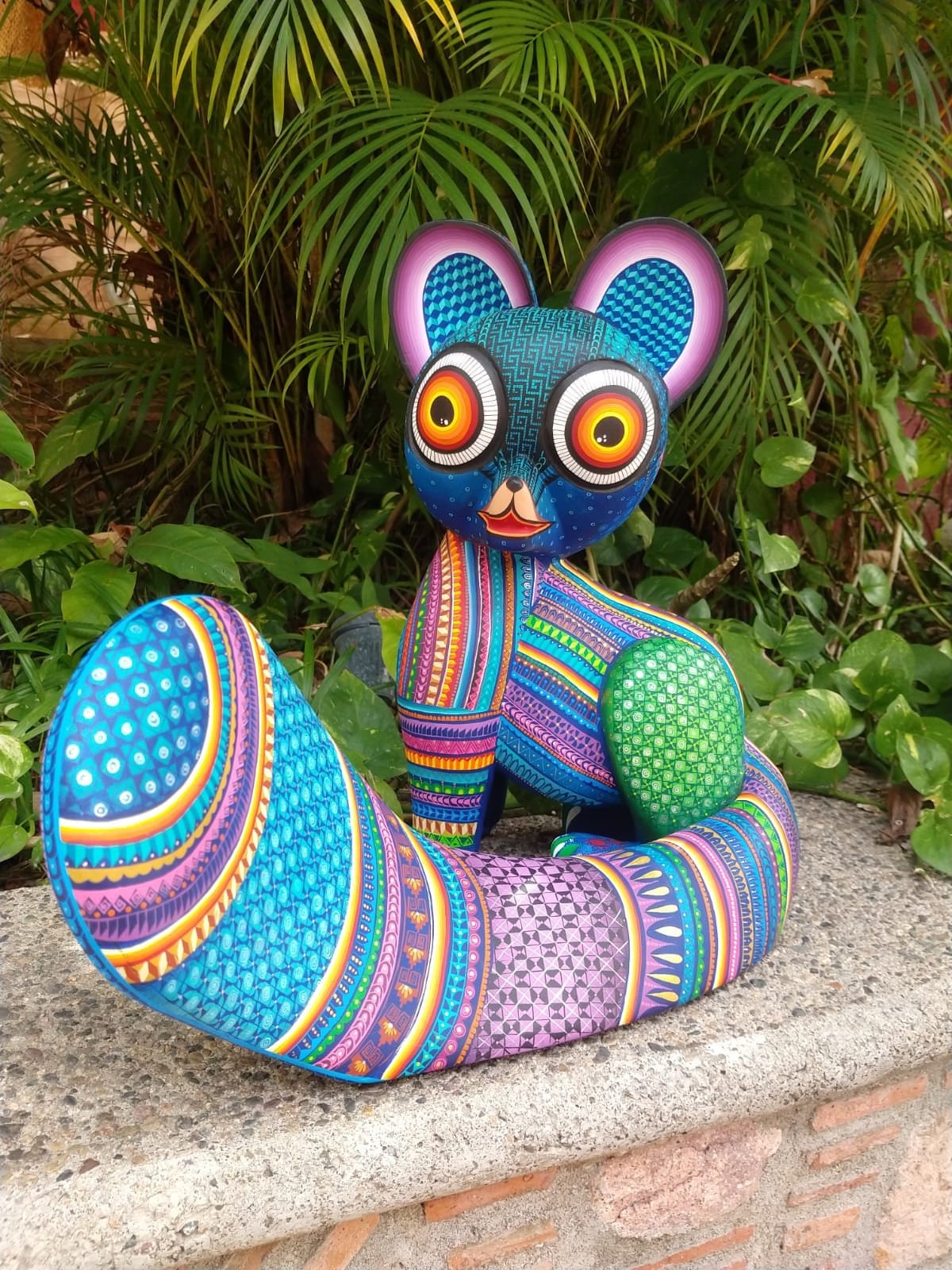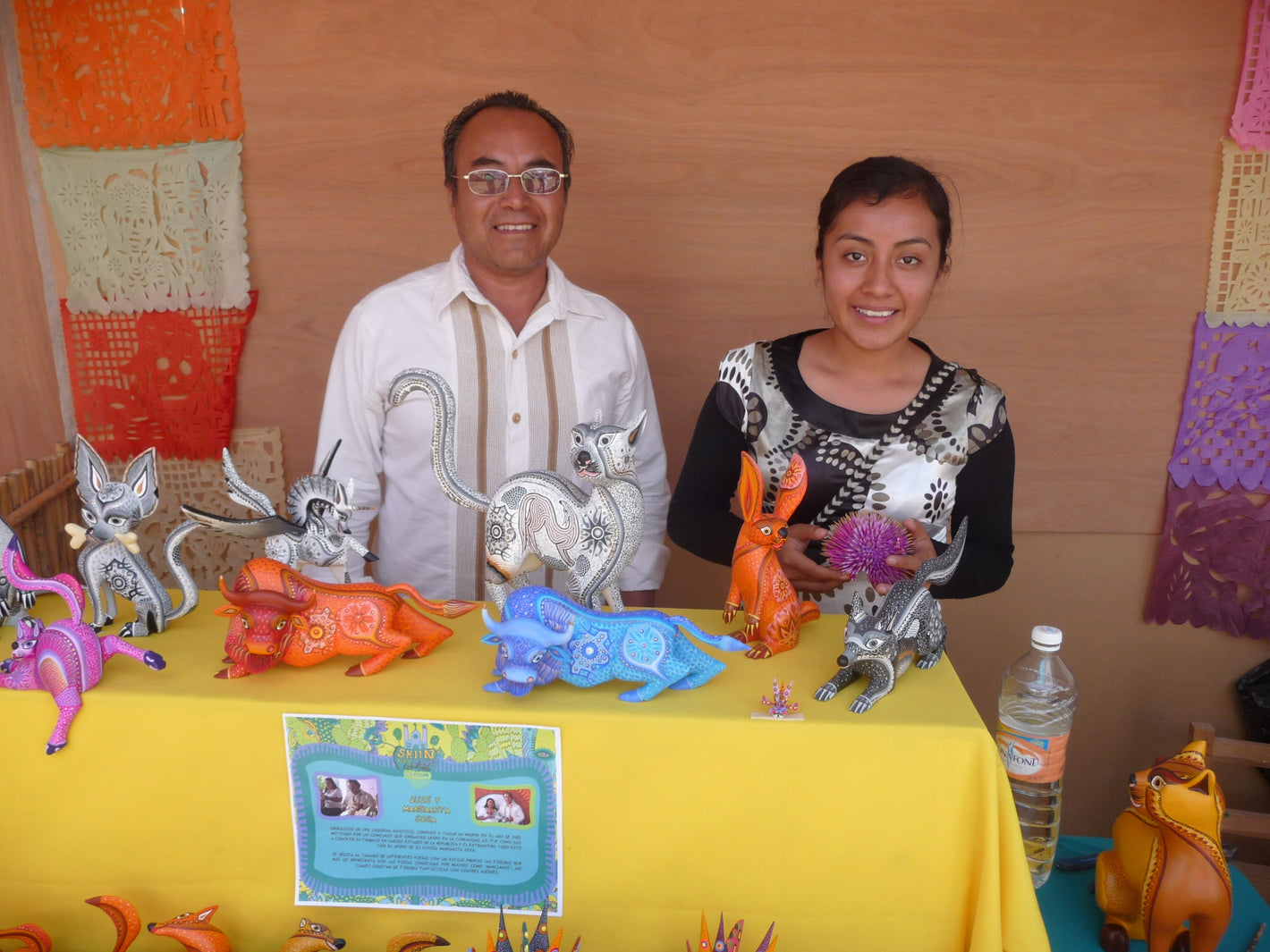Wood Carvings
-

Jacobo & Maria Angeles
Jacobo y Maria Angeles are a couple from San Martin Tilcajete, Oaxaca. One of the most famous villages for the traditional wood carvings, colorful sculptures of imaginative creatures. The Angeles are one of the best artists in all of Mexico. Thus, several art galleries and museums around the globe have permanent exhibitions of their work.
-

Julia Fuentes
Julia Fuentes works together with her husband José Juan Melchor to create beautiful pieces of art. The alebrijes that are the couple’s trademark portray a wonderful sense of movement and curiosity. Julia’s painting style is at the top of the field.
-

Manuel Cruz Prudencio
Manuel Cruz Prudencio is from the town of San Agustin de las juntas, Oaxaca. He learned the craft from his parents, Don Agustin Cruz Tinoco and Doña Cleotilde Prudencio Ramirez. They left their life as farmers to become artisans, and became famous for their religious wood carvings. Manuel started helping his father out in the shop at the age of 5, but didn’t start carving until the age of 11.
-

Ivan Fuentes
Ivan is the youngest son of the legendary woodcarver Epifiano Fuentes. He started painting at the age of 7, with his favorite animal to carve being the anteater. His array of colors and the way he shapes the faces of his animal is what distinguishes himself as an artist.
-

Luis Sosa
Pair text with an image to focus on your chosen product, collection, or blog post. Add details on availability, style, or even provide a review.
-

Estudio 2403
Cesar Melchor is an emerging artist from the town of San Martin Tilcajete. His style is an hommage to his father in law and teacher, Luis Sosa.
Yarn Paintings
-

Hilaria Chavez Carrillo
Pair text with an image to focus on your chosen product, collection, or blog post. Add details on availability, style, or even provide a review.
-

Maximino & Yolanda Renteria
Maximino started his artistic career under the great Jose Benitez Sanchez. Eventually, after working under him for 4 years, Maximino decided to start doing his own work with his wife. Maximino got married in 1993 to Yolanda. The couple started to develop their own style, which is heavily influenced by the classic style of his teacher.
-

Neikame
Neikame is an exceptional artist from Guadalupe Ocotan, in the municipality of La Yesca, Nayarit. Today Neikame believes his art is a reflection of how the Huichol feel in the new world order. Thus, his surreal style is undoubtedly taking Huichol art in a whole new direction.
-

Eliseo Castro
Eliseo Castro was a young man when Kal Muhler took the photos of him that ended up in the book Art of the Huichol ed. K. Berin 1978. Today there are many artists who interpret their myths and beliefs using the traditional yarn technique but Don Eliseo has that mistic style that harks back to the old days when we all lived a simpler life.
-

Luis Castro
Luis Castro is the son of Eliseo Castro, one of the pioneers of huichol yarn paintings. His family comes from the ranch of Los Guayabos, near the town of San Andres Cohamiata. Luis’ designs are much more complex than his father’s. His sense of realism and perspective are taking Wixarika (Huichol) Art in new directions.
-

Justo Benitez
Justo learned his trade from his father Jose Benitez Sanchez. The foremost master of the yarn painting and has a style that reflects his teacher's classic style although he has his own distinct color combinations and super crisp definition. This piece reminds us of the old days when the yarn paintings were not as stylized and were more about the vision rather than the symbols.
Beaded Art
-

Florencio Lopez
Florencio Lopez the son of Don Jacinto Lopez Ramirez, one of the founding fathers of beaded art. Florencio's family, as one of the pioneering families of the art, has been doing the bead art for over 30 years.
-
Morelia Lopez
Pair text with an image to focus on your chosen product, collection, or blog post. Add details on availability, style, or even provide a review.
-
Santos & Esther Bautista
Pair text with an image to focus on your chosen product, collection, or blog post. Add details on availability, style, or even provide a review.
-
Mayola Villa Lopez
Pair text with an image to focus on your chosen product, collection, or blog post. Add details on availability, style, or even provide a review.
-
Isandro Villa Lopez
Pair text with an image to focus on your chosen product, collection, or blog post. Add details on availability, style, or even provide a review.
-
Honorio Villa Lopez
Pair text with an image to focus on your chosen product, collection, or blog post. Add details on availability, style, or even provide a review.
Ceramics
-

Familia Castillo
Pair text with an image to focus on your chosen product, collection, or blog post. Add details on availability, style, or even provide a review.
-

Demetrio Aguilar
Pair text with an image to focus on your chosen product, collection, or blog post. Add details on availability, style, or even provide a review.
-

Aidee
Pair text with an image to focus on your chosen product, collection, or blog post. Add details on availability, style, or even provide a review.
-

Mara
Pair text with an image to focus on your chosen product, collection, or blog post. Add details on availability, style, or even provide a review.
-

Javier Servin
Pair text with an image to focus on your chosen product, collection, or blog post. Add details on availability, style, or even provide a review.
-

Annette Checuan
Pair text with an image to focus on your chosen product, collection, or blog post. Add details on availability, style, or even provide a review.
Textiles
-

Constantino Laura
The tradition of the Andean loom is closely linked to a great spirituality, which represents aptitude and technique. An attitude towards life and, above all, personal growth exercises. Weaving Master Constantino Laura began next to his father, absorbing every detail and every intention as if they were seeds that he would take care of and grow in time. A weaver, painter and poet, Tino comes from a family of weavers from Ayacucho. He is currently one of the most recognized contemporary textile artists in Latin America and his career includes prestigious biennials and textile exhibitions worldwide.
-

Pedro Montaño
The International community has recognized Pedro Motaño for his perfectionist skills. Sheep wool and natural fibers are the materials that he uses for his rugs. Montaño uses ancient techniques, mainly in the dyeing of wool with natural dyes, such as plants, roots, mosses, barks and husks of fruits and trees and mainly indigo paste and the cochineal grana. These same techniques have been used in the making of rugs since prehispanic times.




















